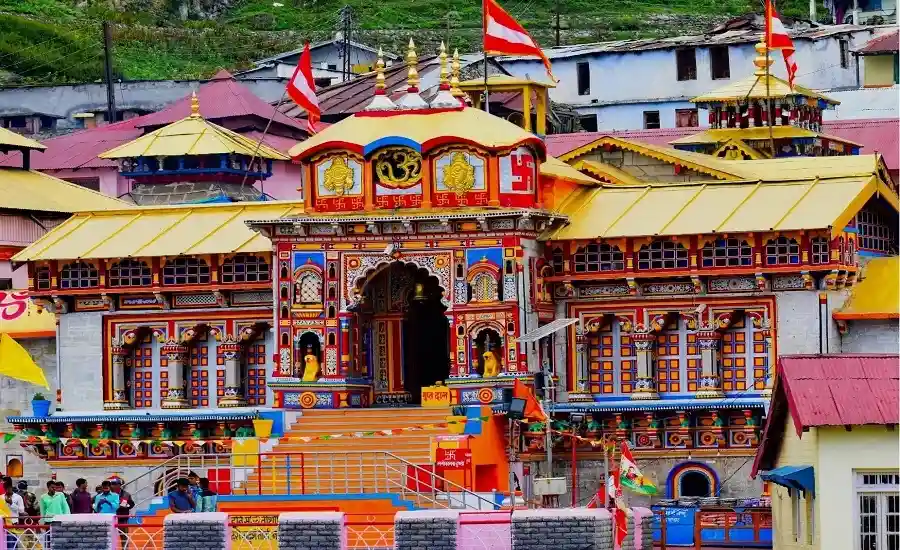Referred to as Lord Vishnu’s abode on Earth, Badrinath Dham is a crucial part of not only the Char Dham Yatra of Uttarakhand but also that of the all-India Chardham Yatra. Along with this, Badrinath or Badri Vishal is also one of the most significant Divya Desams out of the other 108 that are located all over India. The temple is incredibly vibrant looking and attracts the largest number of devotees from all over the world. Surrounded by stunning sites of the snow-clad Himalayan mountain peaks and the lush green rolling hills of the Garhwal Mountains, you will be drenched in deep devotion for Lord Vishnu.

Location
Perched on an elevation of 3,133 meters above sea level, the temple is situated in the Garhwal Himalayan region in the Chamoli district right against the beautiful backdrop of the overlooking Nand Narayan Parvat. People will also be able to experience the Himalayan beauty of the Neelkanth peak, which spreads across the whole region and radiates its peaceful aura. This has to be one of the most easily reachable temples in the Char Dham Yatra circuit, where the pilgrims are required to walk only a few meters to reach the main temple entrance. Located right next to the holy river of Mandakini, Badri Vishal used to be covered in thick forests of Jujube trees (hence the name), which have now become obsolete.
What to Expect
The temple of Badrinath is extremely vibrant looking and decorated with fine and colourful details all over. There are stone facades and arched windows that add to the beauty of the temple, complete with a conical-shaped roof, which is made out of gold gilt. A broad stairway leads the pilgrims up to the main entrance of the temple through the tall and extremely charming-looking arched gateway. Present inside the temple is a Mandap along with a large pillared hall which leads to the inner sanctum where a 1 metre tall statue of Lord Vishnu stands, which is believed to have manifested itself on its own over there.
Best Time to Visit
Just like all the other Char Dham sites of Uttarakhand, Badrinath Dham should also be visited during the summer months of April to June, when the weather is pleasant and the climate is comfortably warm during the daytime. The temperature during this time stays between 15 and 25 degrees Celsius. By night, no matter what time you choose to make the journey, it will be extremely cold, so be prepared for that. Avoid traveling on the hills during the monsoon season when the whole place is prone to unexpected landslides.
Opening and Closing Dates
Opening Dates: The doors for Badrinath Dham are scheduled to open during the holy eve of Akshay Tritiya, which will take place on 4 May 2025. The idol of the presiding deity of Lord Vishnu will be brought in from his winter home in Joshimath after a grand procession.
Closing Dates: The gates of Badrinath Dham shut down every year for the harsh winter months on the holy occasion of Vijayadashami on 23 October 2025. After the closing of the temple and after the idol of Lord Vishnu is taken away to his winter home in Joshimath, the temple remains closed for the pilgrims for 6 months.
Temple Timings
The main Kapat of Badrinath Dham temple opens up as early as 4:30 am and closes at 1:00 pm for lunch and other maintenance services. It opens up once again at 4:00 pm and finally closes down for the night at 9:00 pm after the conclusion of the song Geet Govind.
Puja Rituals and Sevas
Several Aarti and puja services take place in Badrinath Dham, and some of them are – Maha Abhishek, Abhishek, Gita Path, Bhagwat Path and the evening puja rituals include Geet Govind and Aarti. All the daily puja rituals and Aarti are said to have been prescribed by Adi Shankaracharya himself. Unlike most of the Hindu temples in India, all the puja rituals and procedures, even the decoration of the idols, are done in the presence of all the devotees.
Festivals Celebrated
Janmashtami – Generally taking place between August to September, this festival is celebrated with great zeal and enthusiasm. Since this festival is dedicated to Lord Krishna (the 8th avatar of Lord Vishnu), the procession here is done in a grand manner, which is attended by a huge throng of pilgrims from across India.
Mata Murti Ka Mela – celebrated during September, this festival is celebrated to pay honour and reverence to the holy mother of Lord Badrinath, and it also marks the descent of the holy river of Ganga from its heavenly abode to the earthly realm. Among various holy rituals and activities here during the Mela, Vedic scripture renditions of Ashtotram and Sahasranama are done.



 Call
Call WhatsApp
WhatsApp Enquiry
Enquiry